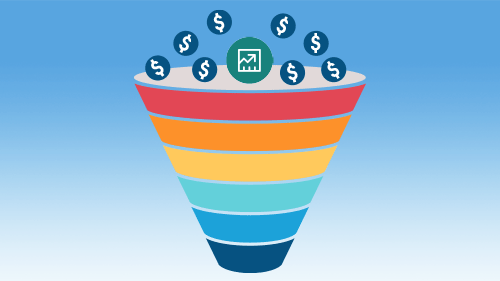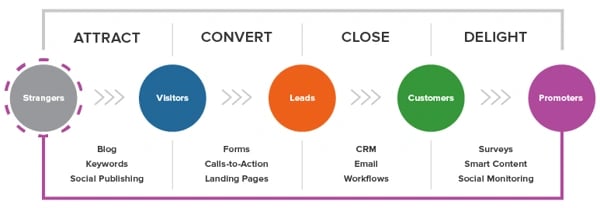Acquiring leads is not enough in our highly-competitive digital era. You need to have a well-defined B2B lead generation funnel in place to convert those leads into paying customers. In this article, we will explore the four key steps to building an effective B2B lead generation funnel that will drive sustainable growth for your business.
Understanding the Importance of a B2B Lead Generation Funnel
Before delving into the specifics of building a B2B lead generation funnel, it's crucial to understand why it is so important to have one. A B2B lead generation funnel is a systematic process that guides your potential customers through each stage of the buyer's journey, from awareness to purchase. A well-constructed funnel allows you to capture leads, nurture them, and ultimately convert them into loyal customers. It provides a framework for tracking and analyzing the effectiveness of your marketing efforts, enabling you to optimize your strategies for maximum ROI.
But what exactly does a B2B lead generation funnel look like? Let's dive deeper into its components and how it can benefit your business.
What is a B2B Lead Generation Funnel?
In simple terms, a B2B lead generation funnel is a visual representation of the steps that a prospect takes towards becoming a customer. It consists of several stages, each designed to move the prospect closer to making a purchase. These stages typically include awareness, interest, consideration, and decision. At each stage, your marketing efforts should be tailored to address the specific needs and concerns of your target audience. By doing so, you can build trust, establish credibility, and guide prospects through the buying process, resulting in higher conversion rates and increased sales.

Let's take a closer look at each stage of the B2B lead generation funnel:
1. Awareness:
During the awareness stage, your goal is to attract the attention of potential customers and make them aware of your brand and the solutions you offer. This can be achieved through various marketing channels such as content marketing, social media, search engine optimization, and targeted advertising.
By creating valuable and informative content that addresses the pain points of your target audience, you can establish yourself as a thought leader and position your brand as the go-to solution provider in your industry.
2. Interest:
Once you have captured the attention of your prospects, the next step is to generate interest in your products or services. This can be done by providing in-depth information, case studies, testimonials, and demonstrations that showcase the value and benefits of choosing your solution.
By highlighting the unique selling points of your offerings and how they can solve the specific challenges faced by your target audience, you can pique their interest and make them consider your brand as a potential solution provider.
3. Consideration:
At the consideration stage, your prospects are actively evaluating different options and comparing them to make an informed decision. This is where you need to provide detailed product information, pricing options, and any additional resources that can help them make a well-informed choice.
By offering personalized consultations, free trials, or product demos, you can address any remaining concerns or objections and provide the necessary reassurance to move them closer to making a purchase decision.
4. Decision:
The final stage of the B2B lead generation funnel is the decision stage, where your prospects are ready to make a purchase. At this point, it's essential to provide a seamless and frictionless buying experience, with clear calls-to-action and easy-to-use purchasing processes.
By offering flexible payment options, guarantees, and excellent customer support, you can instill confidence and encourage prospects to choose your brand over your competitors.
Why is a Lead Generation Funnel Crucial for B2B Businesses?
Unlike B2C transactions, B2B sales cycles are typically longer and more complex. Decision-making in the B2B space involves multiple stakeholders, meticulous research, and a need for trust and credibility. A well-constructed lead generation funnel enables you to navigate this complex sales process effectively.
By nurturing your leads through the different stages of the funnel, you can address their specific pain points, showcase the value of your solutions, and build strong relationships based on trust. This not only increases the likelihood of converting leads into customers but also fosters customer loyalty and advocacy.
In addition, a B2B lead generation funnel allows you to track and measure the effectiveness of your marketing efforts at each stage. This data-driven approach enables you to identify bottlenecks, optimize your strategies, and allocate your resources more efficiently, resulting in a higher return on investment. By understanding the stages of the funnel and tailoring your marketing efforts accordingly, you can drive growth, increase sales, and build long-lasting relationships with your target audience. For that, let’s explore the necessary steps for building an effective B2B funnel lead generation funnel.

Step 1: Identifying Your Target Audience
You must first identify your target audience. Conducting thorough market research is crucial in this step, as it allows you to gather important insights about your potential customers.
The Role of Market Research in Identifying Target Audience
Market research helps you understand the needs, pain points, and preferences of your target audience. By analyzing market trends, conducting competitor analysis, and leveraging consumer data, you can identify the characteristics and behaviors of your ideal customers.
Through market research, you can uncover valuable information such as demographics, psychographics, and buying behaviors. This knowledge will help you create accurate buyer personas, which are fictional representations of your ideal customers.
Creating Buyer Personas for B2B Lead Generation
Once you have gathered the necessary data, it's time to create buyer personas. A buyer persona represents a specific segment of your target audience and includes information such as job title, responsibilities, pain points, goals, and preferred communication channels.
Creating buyer personas allows you to tailor your marketing messages, content, and offers to resonate with your ideal customers. By understanding their motivations and challenges, you can position yourself as a trusted advisor who can provide the solutions they need.
Step 2: Creating Valuable Content
Now that you have a clear understanding of your target audience, it's time to create valuable content that will attract and engage your B2B leads. Content marketing plays a crucial role in generating awareness, establishing thought leadership, and building trust with your prospects.
The Power of Content Marketing in B2B Lead Generation
Content marketing involves creating and distributing relevant, valuable, and educational content to your target audience. By providing information and insights that help your leads solve their problems or achieve their goals, you position your business as a valuable resource. From blog posts and whitepapers to videos and webinars, content marketing offers a variety of formats to engage your audience. It allows you to showcase your expertise, educate your leads, and build credibility, thereby attracting high-quality leads to your funnel.
Types of Content to Attract and Engage B2B Leads
When creating content for B2B lead generation, it's important to diversify your strategy to cater to different preferences and needs. Some effective content types include:
- Informative blog posts and articles
- Case studies and success stories
- Industry reports and research papers
- Video tutorials and demonstrations
- Webinars and online events
Remember to optimize your content for search engines and promote it through various channels, such as social media and email marketing, to maximize its reach and impact.
Step 3: Implementing Lead Capture Strategies
Once you have attracted your B2B leads with valuable content, it's time to capture their information and convert them into prospects. Lead capture is a critical stage in the lead generation funnel and requires strategic planning and implementation.
Designing Effective Landing Pages
A well-designed landing page is essential for capturing lead information and encouraging conversions. It should have a clear and persuasive headline, engaging content, and a compelling call-to-action (CTA).
Keep your landing pages simple, visually appealing, and focused on the value proposition of your offer. Use lead capture forms to collect relevant information, such as name, email address, and company name, while ensuring a seamless user experience.
Utilizing Email Marketing for Lead Capture
Email marketing is a powerful tool for nurturing leads and converting them into customers. By utilizing automated email sequences, you can deliver targeted content, promote offers, and build relationships with your prospects.
Segment your email list based on buyer personas and their stage in the buying journey. Provide personalized content that addresses their specific needs and encourages them to take the next step in the funnel, whether it's requesting a demo, scheduling a call, or making a purchase.
Step 4: Nurturing Leads through the Funnel
Lead nurturing is the process of building relationships with your prospects and guiding them through the different stages of the buying journey. It involves delivering relevant content, engaging with your leads, and providing the information they need to make informed purchase decisions.
The Importance of Lead Scoring
Lead scoring is a methodology used to rank and prioritize leads based on their likelihood to convert into customers. By assigning scores to different engagement activities, such as website visits, email opens, and content downloads, you can identify your most qualified leads.
Lead scoring allows you to focus your resources on high-value prospects, tailor your messaging to their specific needs, and move them through the funnel more efficiently. It enables you to automate your lead nurturing process and deliver personalized experiences to your leads.
Strategies for Effective Lead Nurturing
To nurture your leads effectively, you must provide them with relevant content and personalized experiences at each stage of the funnel. Some strategies are:
- Sending targeted emails based on lead behavior and interests
- Providing case studies and success stories that demonstrate the value of your solutions
- Offering exclusive content or discounts to encourage engagement
- Implementing retargeting ads to stay top-of-mind with your leads
- Engaging with leads on social media and participating in industry conversations.
In the following diagram you'll see a similar lead-nurturing process developed by Hubspot.

Remember: monitoring and analyzing areas for improvement is key to optimize your strategies.
Bottom line
Building an effective B2B lead generation funnel requires careful planning, strategic execution, and continuous optimization. By following the four steps outlined in this article, you can create a robust funnel that drives sustainable growth for your business.
Understanding the importance of a lead generation funnel in the B2B context is the first step towards success. Then, you must identify your target audience, create valuable content, implement lead capture strategies, and nurture those leads through the funnel.
Remember, building a successful B2B lead generation funnel is an ongoing process. Continuously analyze your results, test different approaches, and adapt your strategies to meet the changing needs of your target audience.


-AK-148968-preview.png?width=842&height=310&name=1.01-1x1px-Embertribe-(Client-Services)-AK-148968-preview.png)








-1.jpg)






%20-%20500x500%20-%20SP%20-%2045.01.png)
%20-%20500x500%20-%20SP%20-%2049.01.png)
%20-%20500x500%20-%20SP%20-%2057.01.png)


.png)